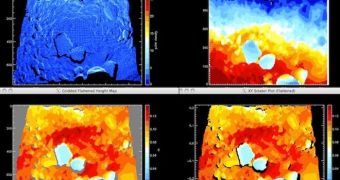The Microsoft Kinect motion sensor can be used to map the underbelly of moving glaciers, a PhD student named Ken Mankoff proved last summer. He made a dive underneath Rieperbreen Glacier in Svalbard, Norway, carrying the sensor, and produced a 3D map of the glacier's underside.
This is an innovative use for a device that was primarily developed to pick up motions for video games. However, this is not the first time scientists hack such tools in order to use them in weird applications.
Mankoff, for example, says that he has always enjoyed modifying inexpensive instruments in order to have them do things not even their manufacturers knew they were capable of. Such was the case with last year's Norwegian expedition.
The PhD student braved nearly frozen water and mud in order to swim inside a small cavern underneath the Rieperbreen Glacier. While swimming to get to his destination, he used a Kinect wrapped in a waterproof bag to image the floor and ceiling of the galleries where he was traveling.
While the method he used to carry out the research was unorthodox by scientific standards, the study itself was very important. Its goal was to analyze how much water gushed through the small cave in which he set up shop, during the summer months.
On glaciers, water from lakes on their surface can drill through the ice until it reaches the bedrock below. When this happens, the rock is lubricated, and makes it easier for the ice to become separated, and flow into the ocean. This behavior promotes ice loss, Wired reports.
Figuring out how this happens, and at what rate, is critically important for making accurate predictions of how the world will react to increased global warming and climate change. Kinect, with its ability to produce very accurate 3D data in visible and infrared wavelengths, was perfectly suited for this task.
Mankoff, who is a PhD student on ice and ocean interactions at the University of California in Santa Cruz, is funded by NASA. He made a presentation of what the Kinect can do on December 8, at the annual meeting of the American Geophysical Union, which was held in San Francisco.
The scientist says that the sensor can collect as many as 9 million data points per second, as opposed to the single data point that a Nintendo Wiimote can. The latter has also been used for a variety of scientific investigations thus far.
“You can go in any store and buy a Kinect for a small price. You can even crash it and then buy another one,” commented City College of New York hydrologist and remote ice sensing expert Marco Tedesco.

 14 DAY TRIAL //
14 DAY TRIAL //